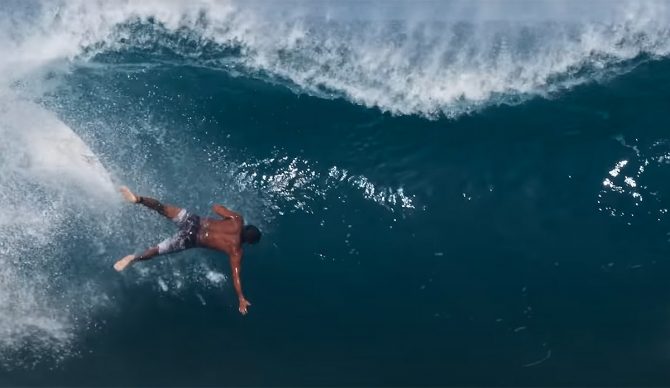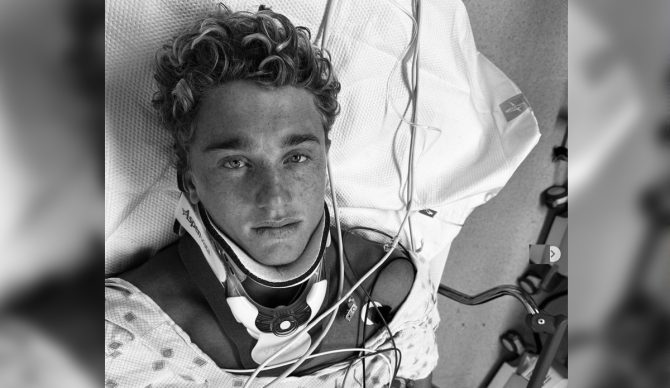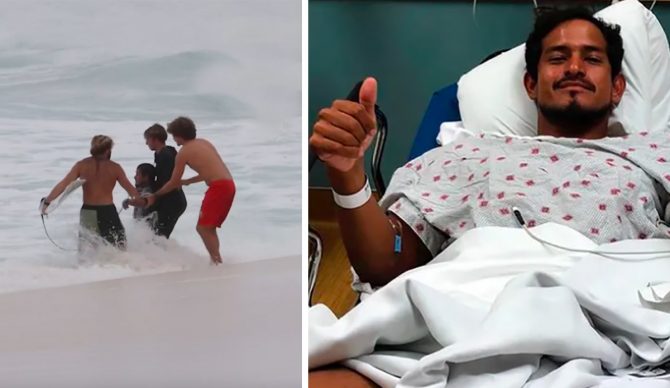
It is Pipe. It’s dangerous. But so is getting caught up in the U.S. medical system. Photo: JOB//Screenshot
I didn’t need another reminder about the maddening practices of healthcare in the U.S., but surfing, of all things, has highlighted the system’s inequities. It’s been depressing to watch professional surfers beg for help with their eye-popping U.S. medical bills in recent weeks. First, supporters of Peruvian pro surfer Joaquin Del Castillo launched a crowdfunding page to cover his $100,000 surgery for a fractured pelvis sustained in a Pipeline wipeout. Soon thereafter, Tahitian pro Eimeo Czermak announced that he was seeking $55,000 via crowdfunding campaign for a spine and head injury suffered at the Vans Pipe Masters.
As Americans, we are uniquely accustomed to stressing over the costs of healthcare. Medical debt is as American as apple pie, rodeos, Walmart, and 16-lane freeways. Americans are shackled by a collective $88 billion in hospital bills, which is baffling because the U.S. spends significantly more on healthcare per capita than any other country – all for a system that lags behind all other high-income countries. A 2023 study showed that 70 percent of Americans feel let down by the system’s costs and inaccessibility.
I’m ashamed of my country’s healthcare system that subjects these surfers to panhandling for money on social media. Anyone who wants to be a competitive pro surfer has to come to the U.S., particularly Hawaii. Thus, to make their dreams come true, these foreign surfers go to great lengths to generate the funds needed, all while navigating the burdensome U.S. immigration processes, just to have their lives turned upside down by a broken healthcare system. Now, ironically, they can’t return to the place where their dreams are made until their hospital debt is settled. They don’t deserve that. No one does.
The comment section on Czermak’s Instagram post is representative of just how backwards the system is. While many showed sympathy and some expressed outrage, others shamed Czermak for not having proper insurance. In Czermak’s crowdfunder he clarified that he knew his travel insurance didn’t cover contests and even though he told the hospital he didn’t have insurance, they required him to stay the night. Additionally, the Vans Pipe Masters doesn’t provide insurance for participants, which, from what I gather, is standard in surf contests.
A relatively simple insurance plan could have solved all these woes. There’s no doubt that these surfers should have been more responsible with their insurance arrangements, especially when throwing themselves over the notoriously unforgiving reef at Pipeline. But instead of pointing the finger at their oversight, we should be focusing our criticism on the root of the problem: the system itself.

Photo: Eimeo Czermak // Instagram
After all, Czermak and Del Castillo are not alone. Americans, including many athletes, often resort to crowdfunding to cover sky-high medical bills. It’s nothing new. In the U.S., uninsured rates have been steadily falling since “Obamacare” launched. But in 2023, seven percent of people were still uninsured – that’s more than 25 million. Moreover, even those who are insured can get caught up in the wrath of healthcare bills.
I’ve done a bit of traveling in my 31 years on Earth and have, admittedly, gone places without travel insurance. But even with insurance, if you read the fine print, you’ll discover that some policies contain dizzying loopholes that don’t cover sport activities like surfing. That said, there are some insurance providers that do cover ocean sports at reasonable rates. For example, with “World Nomads,’” I paid $135 per month for six months of coverage when I lived in Brazil two years ago. I chose this plan because it specifically said recreational surfing was included. Of course, I was surfing playful beach breaks in Rio de Janeiro, not the bone-crunching abyss of a Pipeline tube.
And it’s easy for me to brush that insurance cost off as “reasonable.” For less fortunate people who’ve already exhausted their resources on travel, lodging, and food, whether or not to buy health insurance can, sadly, become a difficult decision.
In an exchange of messages, Del Castillo told me that he travels to Hawaii on a tight budget and the insurance was too expensive. But in hindsight, he strongly insists that any surfer that travels should find a way to budget for insurance. He can’t return to the U.S. until he pays his six-figure debt.

Peruvian Surfer Joaquin Del Castillo suffered a severe pelvis fracture. Photo: GoFundMe
Speaking with a WSL Qualifying Series veteran from the Americas region, I discovered that the WSL does, in fact, offer optional medical insurance to the surfers. The WSL’s insurance, depending on the extent of coverage, costs anywhere from $26 per year for a simple, national plan to $1,200 per year to cover the Qualifying and Challenger Series. Still, as with all insurance, this policy has its holes. It doesn’t cover non-event related trips, for example. This surfer I spoke to also pays for additional travel insurance to fill the gaps of their WSL policy.
In 2012, when I was 20 years old, I suffered an accident of my own abroad. I slipped on a remote waterfall in mainland Mexico and tumbled down some rocks. I went to a small, two-doctor, publicly run clinic to get stitched up and when all was done, I asked the doctors what the cost would be. They returned big grins and said, “Nada.” What a luxury it was to benefit from another country’s social medicine. As an American, it blew my mind to walk out of a hospital without spending a cent.
Thus, I wish Del Castillo and Czermak the best in their journey through astounding health care debt. Their crowdfunding campaigns, as ludicrous as the necessity is, seem to have gained some traction (particularly in Czermak’s case). They are not the first, nor will they be the last, to find themselves in this dire situation. This is life in the United States of America. Hopefully it’s a lesson that other surfers, or contest organizers, can learn from to make sure that they possess comprehensive insurance that keeps them far from American debt collectors. That’s, at least, the band-aid solution. Ideally there would be a systemic change where the U.S. creates a healthcare system in which the people – including visiting surfers – don’t have to feel they’re one fluke hospital visit away from bankruptcy.

